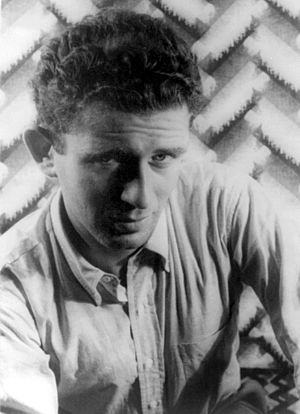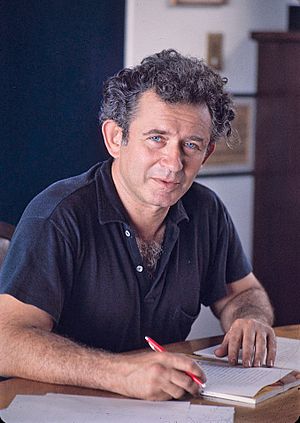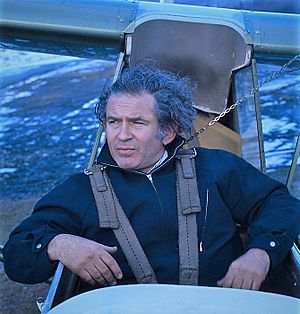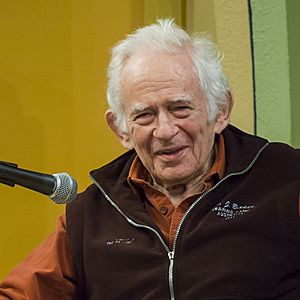Norman Mailer facts for kids
Quick facts for kids
Norman Mailer
|
|
|---|---|

Norman Mailer photographed by Carl Van Vechten in 1948
|
|
| Born | Nachem Malech Mailer January 31, 1923 Long Branch, New Jersey, U.S. |
| Died | November 10, 2007 (aged 84) Manhattan, New York City, U.S. |
| Resting place | Provincetown Cemetery Provincetown, Massachusetts |
| Occupation |
|
| Nationality | American |
| Alma mater | Harvard University |
| Period | 1941–2007 |
| Spouses |
Beatrice Silverman
(m. 1944; div. 1952)Adele Morales
(m. 1954; div. 1962)Beverly Bentley
(m. 1963; div. 1980)Carol Stevens
(m. 1980; div. 1980) |
| Children | 9, including Susan, Kate, Michael, Stephen, and John |
| Signature | |
|
|
|
Norman Mailer (born Nachem Malech Mailer; January 31, 1923 – November 10, 2007) was an American writer. He was a novelist, journalist, playwright, filmmaker, and actor.
Mailer wrote for over sixty years. He had eleven books that became best-sellers. At least one of his books was a best-seller in each of the seven decades after World War II.
His novel The Naked and the Dead came out in 1948. It made him famous early in his career. His 1968 non-fiction book Armies of the Night won the Pulitzer Prize and the National Book Award. Another well-known book is The Executioner's Song, which won the Pulitzer Prize for fiction in 1979.
Mailer helped create "creative non-fiction" or "New Journalism". This style uses storytelling techniques from novels in factual reporting. Other writers like Truman Capote and Tom Wolfe also used this style. Mailer often shared his thoughts on culture through his books and articles. In 1955, he helped start The Village Voice, a weekly newspaper about arts and politics.
Norman Mailer was married six times and had nine children.
Contents
Early Life and Education
Norman Mailer was born on January 31, 1923, in Long Branch, New Jersey. His family was Jewish. His father, Isaac Barnett Mailer, was an accountant. His mother, Fanny, ran a housekeeping agency. Norman's sister, Barbara, was born in 1927.
Mailer grew up in Brooklyn, New York. He went to Boys High School. In 1939, when he was 16, he started at Harvard College. He studied engineering but also took writing classes. His first story, "The Greatest Thing in the World," won a college contest in 1941. He was 18 years old.
After graduating in 1943, Mailer married Beatrice "Bea" Silverman in January 1944. Soon after, he joined the U.S. Army. He hoped to avoid serving by saying he was writing an important book about the war. But his request was denied.
Mailer trained at Fort Bragg. He was then sent to the Philippines with the 112th Cavalry. He worked as a typist and a wire lineman. In 1945, he volunteered for a reconnaissance team. He went on many patrols and was in several small fights. After Japan surrendered, he went to Japan as part of the army. He became a sergeant and a first cook.
Mailer said the army was "the worst experience of my life, and also the most important." While in Japan and the Philippines, he wrote to his wife Bea almost every day. These letters became the basis for his famous novel The Naked and the Dead. He used his experiences as a soldier for the book's main story.
Becoming a Novelist
Norman Mailer wrote twelve novels over 59 years. After studying French in Paris, he returned to the U.S. in 1948. This was shortly after The Naked and the Dead was published.
The Naked and the Dead was a huge success. It was a New York Times best-seller for 62 weeks. It was the only one of his novels to reach the number one spot. Many people called it one of the best American war novels. It sold over a million copies in its first year. It is still seen as a great book about Americans fighting in World War II.
His next novel, Barbary Shore (1951), did not get good reviews. It was a story about Cold War politics. The Deer Park (1955) was based on his time working in Hollywood. It was first turned down by seven publishers. But it became a best-seller and sold over 50,000 copies in its first year.
Mailer's fourth novel, An American Dream, was published in parts in Esquire magazine. It came out from January to August 1964. The book got mixed reviews but was a best-seller.
His fifth novel, Why Are We in Vietnam? (1967), was more experimental. Many critics praised it. Joyce Carol Oates called it "Mailer's most important work" in 1972.
In 1980, The Executioner's Song won the Pulitzer Prize for fiction. This book was a "real-life novel" about the life of Gary Gilmore.
Mailer spent a long time writing Ancient Evenings. This novel was about ancient Egypt around 1100 BC. He worked on it from 1972 to 1983. It was also a best-seller, but reviews were mostly negative.
His last novel, The Castle in the Forest, came out in January 2007. It was about Hitler's childhood. It reached number five on the Times best-seller list. This book received more positive reviews than any of his books since The Executioner's Song. Mailer planned for Castle to be the first part of three books, but he passed away a few months after finishing it.
Journalism and Non-Fiction
From the mid-1950s, Mailer became known for his essays about counterculture. In 1955, he helped start The Village Voice newspaper. He wrote a column called "Quickly: A Column for Slow Readers." These articles helped him develop his ideas about "American existentialism."
Mailer's famous essay "The White Negro" (1957) described the "hipster" figure. This person stood against pressures for everyone to be the same in American society. This essay is one of the most discussed and reprinted essays from that time. Mailer included it in his 1959 book Advertisements for Myself. He said this was the first work he wrote in his own unique style.
In 1960, Mailer wrote "Superman Comes to the Supermarket" for Esquire magazine. It was about John F. Kennedy's rise during the Democratic Party convention. This essay was very important for the new style of writing called New Journalism.
Mailer took part in the October 1967 march on the Pentagon. He wrote a long essay describing the march for Harper's. It was the longest non-fiction piece ever published by an American magazine. He later made it into a book, The Armies of the Night (1968). This book won a National Book Award and a Pulitzer Prize.
Mailer's other major non-fiction books include:
- Miami and the Siege of Chicago (1968), about the 1968 political conventions.
- Of a Fire on the Moon (1971), a report on the Apollo 11 mission to the moon.
- The Fight (1975), about Muhammad Ali's boxing match against George Foreman in 1974.
In these books, Mailer often referred to himself in the third person. He also used many storytelling techniques from fiction in his non-fiction writing.
Filmmaker and Actor
Mailer also worked in film and theater. He wrote a play version of his novel The Deer Park. It was performed in New York City in 1967.
In the late 1960s, Mailer directed three experimental films: Wild 90 (1968), Beyond the Law (1968), and Maidstone (1970). Maidstone included a real fight scene where Mailer was injured.
In 1987, he directed a movie version of his novel Tough Guys Don't Dance.
Mailer also acted in movies. He played Stanford White in the 1981 film Ragtime. In 1999, he played Harry Houdini in Cremaster 2.
In 1976, Mailer worked with Italian filmmaker Sergio Leone. They worked on a movie script based on the novel The Hoods. Parts of Mailer's script later appeared in Leone's film Once Upon a Time in America (1984).
Mailer also appeared in the documentary Town Bloody Hall (1979). In 1982, he wrote the screenplay for a TV movie based on The Executioner's Song. It won two Emmy awards.
Biographer
Mailer wrote biographies in a unique way. He would use his own feelings and thoughts to understand the people he wrote about. His biographer, J. Michael Lennon, said Mailer explored the "psychic depths" of people like Pablo Picasso, Muhammad Ali, and Marilyn Monroe.
Mailer's 1973 biography of Marilyn Monroe was very popular. It sold more copies than any of his other books except The Naked and the Dead. Mailer did not research every fact about Monroe's death. Instead, he said, "I speculated." This made the book controversial.
Later, Mailer explained his approach. He said his biographies were like "a species of novel" that followed the rules of biography.
Activism and Politics
Many of Mailer's non-fiction books, like The Armies of the Night, were about politics. He covered the Republican and Democratic National Conventions many times.
Mailer believed the Cold War was not good for America. He thought it made the government too strong and involved in people's lives. He argued that conservative politicians supported the Cold War for political reasons.
In October 1967, Mailer was arrested during an anti–Vietnam War protest at the Pentagon. In 1968, he signed a pledge to refuse tax payments to protest the war.
From 1980 until his death, Mailer supported Democratic Party candidates.
Running for Mayor
In 1969, Norman Mailer ran for mayor of New York City. He ran with columnist Jimmy Breslin. They suggested that New York City should become its own 51st state.
Mailer had ideas on many issues. He wanted to stop adding fluoride to the water. He also wanted to release Black Panther Party leader Huey P. Newton. But his main idea was to break up the city into smaller towns and neighborhoods. These smaller areas would have their own schools, police, and housing programs. Their campaign slogan was "throw the rascals in."
Mailer finished fourth out of five candidates. A historian named Theodore H. White called his campaign "one of the most serious campaigns" of that time. Mailer himself joked about his campaign, saying, "The difference between me and the other candidates is that I'm no good and I can prove it."
Personal Life
Norman Mailer was married six times and had nine children. He had eight children with his wives and adopted his sixth wife's son.
His first marriage was to Beatrice Silverman in 1944. They had one child, Susan. They divorced in 1952.
His third wife was Lady Jeanne Campbell, a British journalist. They married in 1962 and divorced in 1963. They had a daughter, actress Kate Mailer.
His fourth wife was Beverly Bentley, an actress. They married in 1963. She was the mother of two of his sons, producer Michael Mailer and actor Stephen Mailer. They divorced in 1980.
His fifth wife was Carol Stevens, a jazz singer. They married and divorced in 1980 to make their daughter Maggie, born in 1971, legitimate.
His sixth and last wife was Norris Church Mailer (born Barbara Jean Davis). They married in 1980. They had one son, John Buffalo Mailer, who is a writer and actor. Mailer also raised and adopted Matthew Norris, his wife's son from her first marriage.
Working with his Children
In 2005, Mailer wrote a book called The Big Empty with his youngest son, John Buffalo Mailer. Mailer also appeared in a 2004 episode of Gilmore Girls with his son Stephen Mailer.
Death and Legacy
Norman Mailer passed away on November 10, 2007. He died from kidney failure in Manhattan, New York. He is buried in Provincetown Cemetery in Provincetown, Massachusetts.
Mailer's papers, including thousands of letters, are kept at the Harry Ransom Center at the University of Texas at Austin.
In 2003, the Norman Mailer Society was created to help keep his work remembered. In 2008, The Norman Mailer Center was started to honor him. It offers programs like the Norman Mailer Prize, which began in 2009.
In 2014, Mailer's biographer, J. Michael Lennon, published a book of 712 of Mailer's letters. These letters cover his life from the 1940s to the early 2000s.
In 2018, the Library of America published two collections of Mailer's works from the 1960s. Some critics believe Mailer's writings are still important today.
In May 2018, a bronze plaque was placed in Long Branch, New Jersey, where Mailer's family hotel used to stand.
In 2019, Wilkes University opened a replica of Mailer's last study. It includes some of his books, writings, and furniture. It also has his entire 4,000-volume library from his home in Brooklyn.
Norman's oldest daughter, Susan Mailer, wrote a book in 2019 about her relationship with her father. It is called In Another Place: With and Without My Father Norman Mailer.
Works
Novels
- The Naked and the Dead. New York: Rinehart, 1948.
- Barbary Shore. New York: Rinehart, 1951.
- The Deer Park. New York: Putnam's, 1955.
- An American Dream. New York: Dial, 1965.
- Why Are We in Vietnam? New York: Putnam, 1967.
- A Transit to Narcissus. New York: Howard Fertig, 1978.
- The Executioner's Song Boston: Little, Brown and Company, 1979.
- Of Women and Their Elegance. New York, Simon and Schuster, 1980.
- Ancient Evenings. Boston: Little, Brown, 1983.
- Tough Guys Don't Dance. New York: Random House, 1984.
- The Gospel According to the Son. New York: Random House, 1997.
- The Castle in the Forest. New York: Random House, 2007.
Plays and Screenplays
- The Deer Park: A Play. New York: Dial, 1967.
- Maidstone: A Mystery. New York: New American Library, 1971.
Short Stories
- The Short Fiction of Norman Mailer. New York: Dell, 1967.
Poetry
- Deaths for the Ladies (And Other Disasters). New York: Putman, 1962.
- Modest Gifts: Poems and Drawings. New York: Random House, 2003.
Essays
- "The White Negro." San Francisco: City Lights, 1957.
- The Bullfight: A Photographic Narrative with Text by Norman Mailer. New York: Macmillan, 1967.
- The Faith of Graffiti. New York: Praeger, 1974.
- Why Are We At War? New York: Random House, 2003.
Letters
- Norman Mailer's Letters on An American Dream, 1963-1969. Shavertown, PA: Sligo Press, 2004.
- The Selected Letters of Norman Mailer. New York: Random House, 2014.
Non-fiction Narratives
- The Armies of the Night. New York: New American Library, 1968.
- The Idol and the Octopus: Political Writings on the Kennedy and Johnson Administrations. New York: Dell, 1968.
- Miami and the Siege of Chicago: An Informal History of the Republican and Democratic Conventions of 1968. New York: New American Library, 1968.
- Of a Fire on the Moon. Boston: Little, Brown, 1971.
- King of the Hill: Norman Mailer on the Fight of the Century. New York: New American Library, 1971.
- St. George and The Godfather. New York: Signet Classics, 1972.
- The Fight. Boston: Little, Brown and Company, 1975.
- Of a Small and Modest Malignancy, Wicked and Bristling with Dots. Northridge, CA: Lord John Press, 1980.
- Oswald's Tale: An American Mystery. New York: Random House, 1995.
Miscellanies, Anthologies, and Collections
- Advertisements for Myself. New York: Putnam, 1959.
- The Presidential Papers. New York: Putnam, 1963.
- Cannibals and Christians. New York: Dial, 1966.
- The Long Patrol: 25 Years of Writing from the Work of Norman Mailer. New York: World, 1971.
- Existential Errands. Boston: Little, Brown, 1972.
- Some Honorable Men: Political Conventions, 1960-1972. Boston: Little, Brown, 1976.
- Pieces and Pontifications. Boston: Little, Brown and Company, 1982.
- Conversations with Norman Mailer. Jackson: University Press of Mississippi, 1988.
- The Time of Our Time. New York: Random House, 1998.
- The Spooky Art: Some Thoughts on Writing. New York: Random House, 2003.
- The Big Empty. New York: Nation Books, 2006.
- On God: An Uncommon Conversation. With J. Michael Lennon. New York: Random House, 2007.
Biographies
- Marilyn: A Biography. New York: Grosset & Dunlap, 1973.
- Portrait of Picasso as a Young Man: An Interpretive Biography. Atlantic Monthly Press, 1995.
- Oswald's Tale: An American Mystery. New York: Random House, 1996.
Awards and Honors
- 1969: Pulitzer Prize, George Polk Award, and National Book Award for The Armies of the Night; Honorary Doctor of Letters from Rutgers University
- 1970: Harvard University's Signet Society Medal for Achievement in the Arts
- 1973: Edward MacDowell Medal
- 1980: Pulitzer Prize for Executioner's Song
- 1984: Honorary Doctor of Letters from Mercy College; Inducted into the American Academy of Arts and Letters
- 1985: Lord and Taylor's Rose Award
- 1987: Independent Spirit Award for best film (for Tough Guys Don't Dance)
- 1989: PEN Oakland / Josephine Miles Award; Emerson-Thoreau Medal
- 1991: New York State Edith Wharton Citation of Merit
- 1994: Harvard University's Signet Society Medal for Achievement in the Arts
- 1995: Honorary Doctor of Letters from Wilkes University
- 2000: F. Scott Fitzgerald Award for Achievement in American Literature
- 2002: Lifetime Achievement Award from the James Jones Literary Society; Austrian Cross of Honour for Science and Art, 1st class
- 2004: Golden Plate Award of the American Academy of Achievement
- 2005: National Book Award for Distinguished Contribution to American Letters
|
See Also
 In Spanish: Norman Mailer para niños
In Spanish: Norman Mailer para niños
- List of peace activists





